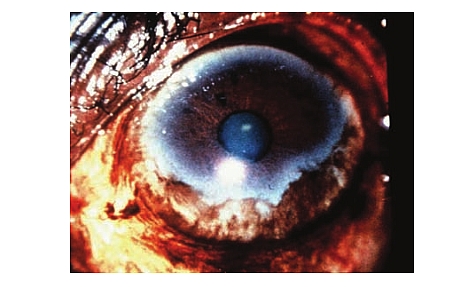River Blindness is also known as Onchocerciasis and it is an infectious disease caused by Onchocerca volvulus which is transmitted by Black fly of the genus Similium (example is Simulium damnosum) which is the vector; this disease is an important cause of blindness in Africa and its ocular features include sclerosing keratitis, uveitis, chorioretinitis and optic neuritis invariably ending in optic atrophy. It is called River blindness because the vector breeds in fast flowing water as that of rivers and streams and because the disease causes Blindness, it was then named as River Blindness.
Table of Contents
- Onchocerciasis Epidemiology
- Onchocerciasis Pathogenesis
- How is Onchocerciasis Spread? (Onchocerciasis Mode of Transmission)
- Onchocerciasis Risk Factors
- Onchocerciasis Symptoms and Signs
- How do you Diagnose Onchocerciasis? (Onchocerciasis Diagnosis )
- Onchocerciasis Treatment (River blindness Treatement)
- Onchocerciasis Complications
- Onchocerciasis Prevention
Onchocerciasis Epidemiology
Onchocerciasis is an important cause of blindness worldwide, causing blindness in about 300,000 affected persons per year. About 125 million people worldwide are at risk of infection with 96% in Africa. Onchocerciasis is endemic in 37 countries among which 30 countries are in Sub-Saharan Africa, 6 countries in the Americas and 1 country in the Arabian peninsula.
About 40 million people are infected with Onchocerciasis with 99% of cases in Africa – 6.5 million of those infected suffer from severe itching or dermatitis and 300,000 becoming blind while about 500,000 cases will have severe visual impairment. There are about 400,000 new blind cases of Onchocerciasis every year. In Nigeria, more than 32 million Nigerians in 32 states and the Federal Capital Territory (FCT) are estimated to be at risk for Onchocerciasis. Nigeria accounts for 40 percent of the 40 million people infected with onchocerciasis worldwide.
Onchocerciasis Pathogenesis
Microfilariae gain entry into the skin when the female black fly (e.g. Simulium damnosum ) bites a human for a blood meal. The microfilariae develop into infective larvae in the black fly and moves to its mouth and are then transmitted to a human with the next bite. Following moulting, the larvae develop into adult worms in the human body and are found coiled up in fibrous nodules in the skin and subcutaneous tissue. The microfilariae produced after mating by adult worms will then migrate through the dermis and connective tissue where the symptoms such as itching due to skin rash with darkened pigmentation occur. The thickened skin may appear dry, scaly, and thick as that of a Lizard (“lizard skin”). Microfilariae may also migrate to the eyes where they cause blindness .
How is Onchocerciasis Spread? (Onchocerciasis Mode of Transmission)
Onchocerciasis is spread through a bite from an infected black fly called Simulium species which serves as the vector. The black fly that transmits Onchocerciasis loves breeding in fast flowing water that is well oxygenated.
Onchocerciasis Risk Factors
- Living in communities near breeding sites of simulium species of black flies
- Having occupation near breeding sites of the vector black fly such as being a farmer, fisherman or sand digger
Onchocerciasis Symptoms and Signs
The clinical features of Onchocerciasis can be divided or grouped into two main categories: the Ocular symptoms and signs and Non-Ocular symptoms and signs. The ocular symptoms and signs refer to the clinical features that arise that are related to the effect of the disease on the eyes while any other effect outside of the eyes is referred to as the Non-ocular symptoms and signs.
Ocular symptoms and signs of Onchocerciasis
- Living microfilaria could be seen floating in the anterior chamber of the eyes
- Punctate keratitis
- Sclerosing keratitis
- Acute and chronic uveitis
- Secondary glaucoma and cataract
- Choroido-retinitis
- Choroido-retinal atrophy
- Acute optic neuritis
- Optic atrophy
- Visual field loss
- Night blindness
Non-Ocular symptoms and signs of Onchocerciasis
- Severe itching (Pruritus) and dermatitis the itching can be severe and disabling and could lead to atrophy of the skin and discoloration
- Formation of Subcutaneous nodules in deeper structures of the skin as a result of the curled-up adult worms that are being surrounded by fibrous tissue
- Lymph nodes enlargement (Lymphadenopathy)
- Hanging groin
- Hyposexuality (reduced interest in sexual activity)
- Dwarfism
- Epilepsy
How do you Diagnose Onchocerciasis? (Onchocerciasis Diagnosis )
- Diagnosis can be made by identifying the microfilariae in superficial skin biopsies, or by identifying adult worms in skin nodules (known as Onchocercomata)
- Microfilariae can often be seen floating in the eye (in the cornea and anterior chamber) using slit lamp examination.
- Antibodies may be detected in the blood and PCR techniques have also been used to detect filarial DNA in skin scrapings
Onchocerciasis Treatment (River blindness Treatement)
- Ivermectin is the drug of choice and it is used for treatment of Onchocerciasis using the Community Directed Treatment with Ivermectin (CDTI or ComDT). Ivermectin is only effective against the microfilariae and not the adult worms.
- Nodulectomy to surgically remove the nodule and the adult worm
Onchocerciasis Complications
- Onchocercomata these are multiple subcutaneous nodules seen in bony prominences in patients having Onchocerciasis and they are usually treated by excision of the nodules after taking a dose of Ivermectin
- Blindness Onchocerciasis is an important cause of blindness worldwide
Onchocerciasis Prevention
- Destruction of vectors (Simulium) breeding sites by use of larvicidal agents: this method of control of Onchocerciasis was used by the Onchocerciasis Control Program (OCP) in West Africa from 1974-2002. It helped to reduce onchocerciasis from OCP countries such as Senegal, Mali, Guinea Bissau, Guinea, Burkina Faso, Cote dIvoire, Niger, Sierra Leone, Ghana, Togo, and Benin.
- Use of drugs for mass treatment of Onchocerciasis to reduce transmission. The drug commonly used is Ivermectin (Mectizan) this drug was used in the African Program for Onchocerciasis Control (APOC in 1996) and also in the Onchocerciasis Elimination Program of the Americas (OEPA) in 1992 ( it was aimed at eliminating onchocerciasis as a public health and socio-economic problem)


